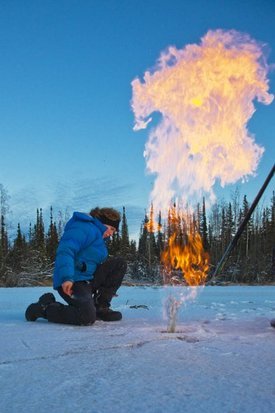Ticking Greenhouse Gas Time Bomb: Melting Permafrost
By Seth Borenstein
01 December, 2011
Associated Press
WASHINGTON - Massive amounts of greenhouse gases trapped below thawing permafrost will likely seep into the air over the next several decades, accelerating and amplifying global warming, scientists warn.
Those heat-trapping gases under the frozen Arctic ground may be a bigger factor in global warming than the cutting down of forests, and a scenario that climate scientists hadn't quite accounted for, according to a group of permafrost experts. The gases won't contribute as much as pollution from power plants, cars, trucks and planes, though.

This handout photo, taken in 2009, provided by University of Alaska, Fairbanks, shows research assistant professor Katey Walter Anthony igniting trapped methane from under the ice in a pond on the Fairbanks campus. (AP Photo/Todd Paris, University of Alaska, Fairbanks)
The permafrost scientists predict that over the next three decades a total of about 45 billion metric tons of carbon from methane and carbon dioxide will seep into the atmosphere when permafrost thaws during summers. That's about the same amount of heat-trapping gas the world spews during five years of burning coal, gas and other fossil fuels
And the picture is even more alarming for the end of the century. The scientists calculate that about than 300 billion metric tons of carbon will belch from the thawing Earth from now until 2100.
Adding in that gas means that warming would happen "20 to 30 percent faster than from fossil fuel emissions alone," said Edward Schuur of the University of Florida. "You are significantly speeding things up by releasing this carbon."
Usually the first few to several inches of permafrost thaw in the summer, but scientists are now looking at up to 10 feet of soft unfrozen ground because of warmer temperatures, he said. The gases come from decaying plants that have been stuck below frozen ground for millennia.
Schuur and 40 other scientists in the Permafrost Carbon Research Network met this summer and jointly wrote up their findings, which were published in the journal Nature on Wednesday.
"The survey provides an important warning that global climate warming is likely to be worse than expected," said Jay Zwally, a NASA polar scientist who wasn't part of the study. "Arctic permafrost has been like a wild card."
When the Nobel Prize-winning panel of climate scientists issued its last full report in 2007, it didn't even factor in trapped methane and carbon dioxide from beneath the permafrost. Diplomats are meeting this week in South Africa to find ways of curbing human-made climate change.
Schuur and others said increasing amounts of greenhouse gas are seeping out of permafrost each year. Some is methane, which is 25 times stronger than carbon dioxide in trapping heat.
In a recent video, University of Alaska Fairbanks professor Katey Walter Anthony, a study co-author, is shown setting leaking methane gas on fire with flames shooting far above her head.
"Places like that are all around," Anthony said in a phone interview. "We're tapping into old carbon that has been locked up in the ground for 30,000 to 40,000 years."
That triggers what Anthony and other scientists call a feedback cycle. The world warms, mostly because of human-made greenhouse gases. That thaws permafrost, releasing more natural greenhouse gas, augmenting the warming.
There are lots of unknowns and a large margin of error because this is a relatively new issue with limited data available, the scientists acknowledge.
"It's very much a seat-of-the-pants expert assessment," said Stanford University's Chris Field, who wasn't involved in the new report.
The World Meteorological Organization this week said the worst of the warming in 2011 was in the northern areas - where there is permafrost - and especially Russia. Since 1970, the Arctic has warmed at a rate twice as fast as the rest of the globe.
The thawing permafrost also causes trees to lean - scientists call them "drunken trees" - and roads to buckle. Study co-author F. Stuart Chapin III said when he first moved to Fairbanks the road from his house to the University of Alaska had to be resurfaced once a decade.
"Now it gets resurfaced every year due to thawing permafrost," Chapin said.
© 2011 Associated Press
Comments are not moderated. Please be responsible and civil in your postings and stay within the topic discussed in the article too. If you find inappropriate comments, just Flag (Report) them and they will move into moderation que.


